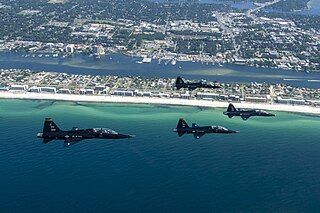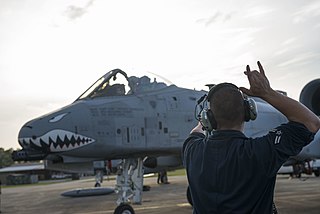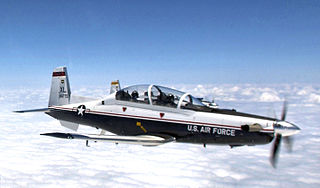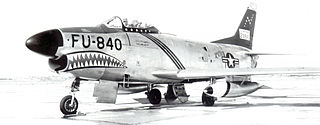
The Air Force Test Center (AFTC) is a development and test organization of the United States Air Force. It conducts research, development, test, and evaluation of aerospace systems from concept to deployment. It has test flown every aircraft in the Army Air Force's and the Air Force's inventory since World War II. The center employs nearly 13,000 people, and controls the second largest base in the Air Force.

The 18th Fighter Interceptor Squadron is a subordinate unit of the 354th Fighter Wing based at Eielson Air Force Base in Alaska, and flies the Block 30 General Dynamics F-16C/D aircraft.

The 412th Test Wing is a wing of the United States Air Force, assigned to the Air Force Test Center at Edwards Air Force Base, California.

The 2nd Fighter Training Squadron, sometimes written as 2d Fighter Training Squadron, is an active United States Air Force unit, assigned to the 325th Operations Group at Tyndall Air Force Base, Florida.

The 197th Air Refueling Squadron is a unit of the Arizona Air National Guard 161st Air Refueling Wing located at Goldwater Air National Guard Base, Phoenix, Arizona. The 197th is equipped with the KC-135R Stratotanker.

The 75th Fighter Squadron(75 FS) is a United States Air Force unit. It is assigned to the 23d Fighter Group, Air Combat Command and stationed at Moody Air Force Base, Georgia. The squadron is equipped with the Fairchild Republic A-10C Thunderbolt II attack aircraft.

The 84th Flying Training Squadron was part of the United States Air Force 47th Flying Training Wing based at Laughlin Air Force Base, Texas. It operated Beechcraft T-6 Texan II aircraft conducting flight training.

The 31st Combat Training Squadron is an active United States Air Force unit. It is currently assigned to the Nevada Test and Training Range at Nellis Air Force Base, Nevada.

The 15th Test and Evaluation Squadron is a United States Air Force unit, stationed at Eglin Air Force Base, Florida and assigned to the 753rd Test and Evaluation Group. It was first activated in the expansion of the United States military forces prior to World War II as the 15th Pursuit Squadron. It moved to Panama in 1942, where it participated in the defense of the Panama Canal. It returned to the United States, where it was a Replacement Training Unit for fighter pilots until 1944, when it was disbanded as the 15th Fighter Squadron in a reorganization of Army Air Forces training units in 1944

The 46th Fighter Training Squadron is an inactive United States Air Force unit. Its last assignment was with the 917th Operations Group at Barksdale Air Force Base, Louisiana. where it was inactivated on 1 October 1993.

The 337th Flight Test Squadron was most recently part of the 46th Test Wing and based at McClellan Air Force Base, California. It performed depot acceptance testing until being inactivated with the closure of McClellan on 13 July 2001.

The 416th Flight Test Squadron is a United States Air Force squadron. It is assigned to the 412th Operations Group, Air Force Materiel Command at Edwards Air Force Base, California. The 416th performs flight testing on General Dynamics F-16 Fighting Falcon aircraft.

The 418th Flight Test Squadron is a United States Air Force squadron. It is assigned to the 412th Operations Group, Air Force Materiel Command, stationed at Edwards Air Force Base, California.

The 461st Flight Test Squadron is a United States Air Force squadron, assigned to the 412th Operations Group of Air Force Materiel Command, and is stationed at Edwards Air Force Base, California. The Squadron performs flight testing on the Lockheed Martin F-35 Lightning II.

The 29th Test and Evaluation Squadron is an active United States Air Force unit. It is assigned to the 753d Test and Evaluation Group, at Eglin Air Force Base, Florida.

The 53rd Test and Evaluation Group is a group of the United States Air Force. It is a part of the 53rd Wing, and is headquartered at Nellis AFB, Nevada.

The 482d Fighter-Interceptor Squadron is an inactive United States Air Force unit. Its last assignment was with Montgomery Air Defense Sector at Homestead Air Force Base, Florida in 1969. During World War II the squadron was a Replacement Training Unit until disbanded in 1944 when the Army Air Forces converted training units to Army Air Force Base Units. It was reconstituted in 1955 and served as a fighter interceptor squadron until 1969.

The 530th Air Defense Group is a disbanded United States Air Force organization. Its last assignment was with the 9th Air Division at Geiger Field, Washington, where it was inactivated on 18 August 1955. The group was originally activated as the 530th Air Service Group, a support unit for the 301st Bombardment Group at the end of World War II in Italy and then redeployed to the United States where it continued to support the 301st until it was inactivated in 1945.

The 566th Air Defense Group is a disbanded unit of the United States Air Force. Its last assignment was with the 28th Air Division at Hamilton Air Force Base, California, where it was inactivated on 18 August 1955. The group was originally activated as the 566th Air Service Group, a support unit for a combat group at the end of World War II but never deployed before it was inactivated in 1945.

The 527th Air Defense Group is a disbanded United States Air Force organization. Its last assignment was with the 4708th Air Defense Wing at Wurtsmith Air Force Base, Michigan, whre it was inactivated on 18 August 1955. The group was originally activated as the 527th Air Service Group, a support unit for the 461st Bombardment Group at the end of World War II in Italy and then redeployed to the United States where it was inactivated in 1945.






























